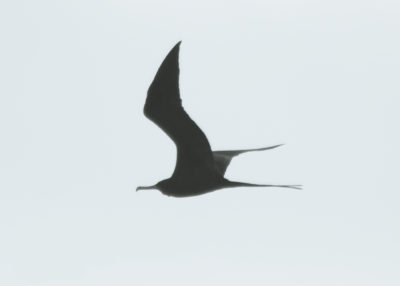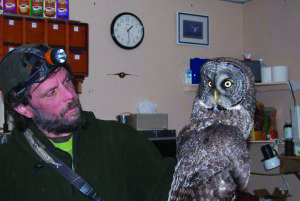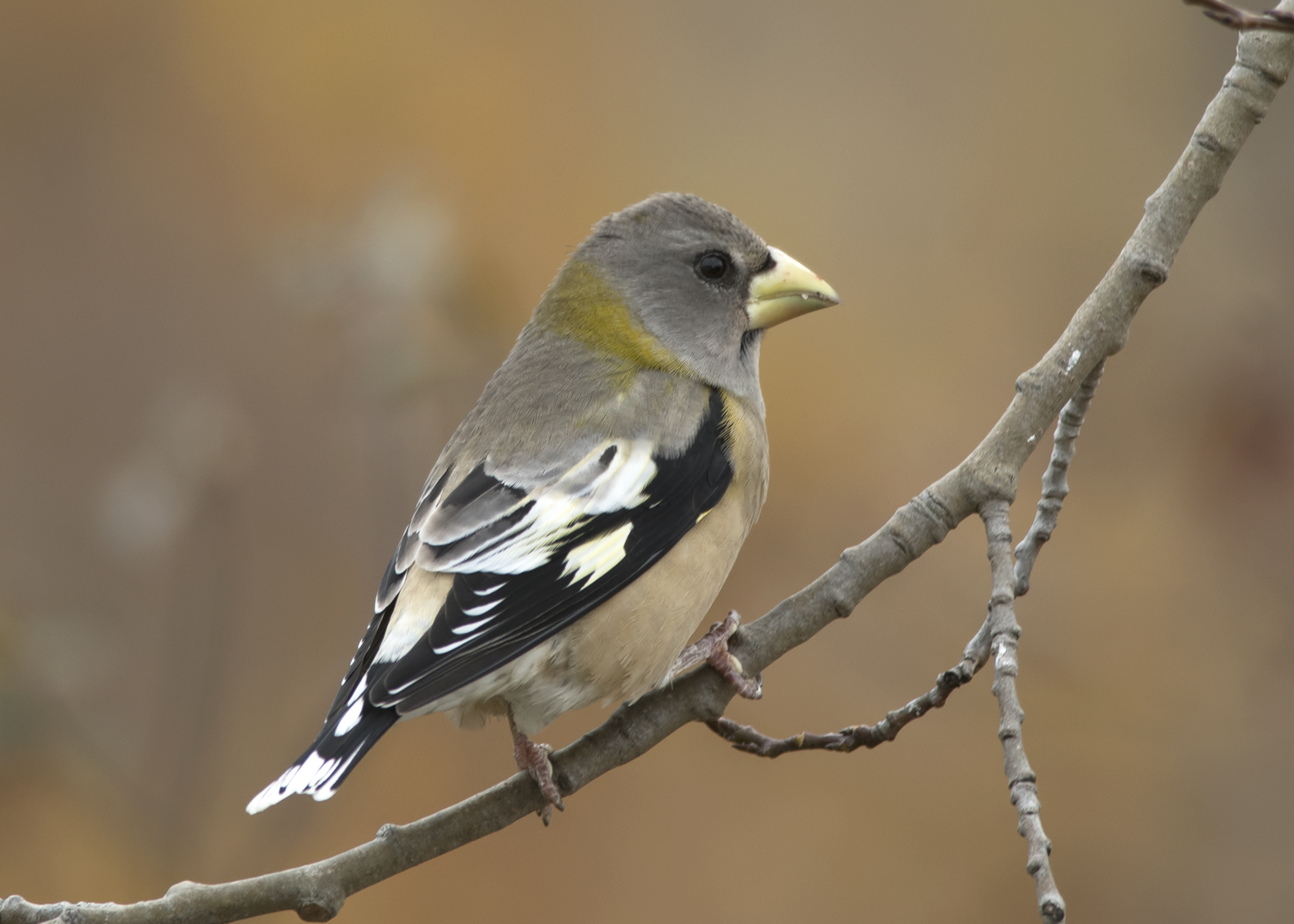The 2020 fall field season at Whitefish Point Bird Observatory (WPBO) ran from Aug. 15 through Nov. 15. During that period, the field staff recorded 115,446 individual birds of 221 species and three additional taxa. The species observed this fall included 35 species of waterfowl, 29 shorebird species, eight owl species, and nine finch species. Although it was a relatively “tame” season for vagrants by WPBO standards, we were thrilled to document the first records for frigatebird and Barn Owl at WPBO. Unfortunately, because the frigatebird was an adult male, it is unlikely that it will be possible to identify it to species (but Magnificent Frigatebird is the most likely candidate). Regardless, I’ll never forget hearing waterbird counter Steve Backus’s radio call, “Chris, there’s a frigatebird over the harbor.”

A frigatebird was one of the vagrants seen at WPBO in the fall of 2020.
Photo by Chris Neri
While the chance of seeing a vagrant is always a possibility at Whitefish Point, it is more often the overall migration of the more common species that makes-or-breaks a given day or even a season for the field staff. The early season is the time when we hope for the best warbler migration, but it proved to be a bit lackluster this fall, with a total of 2,033 warblers of 23 species being documented. Whereas the warbler migration was somewhat disappointing, the early season began providing some signs of the finch flight that would be one of the late season’s highlights.
Conducting songbird surveys at WPBO in late fall can be quite daunting at times. The vast majority of migrant songbirds have already moved through, and weeks of harsh winter conditions are not unexpected. Weeks of walking the woods under gray skies, with no feeling in your fingers and toes, gets old quickly when the birds aren’t there to occupy one’s mind. Conversely, when the winter finches are present in good numbers, it is a joy to witness their migration. Last fall, we did not document a single Common Redpoll or Pine Grosbeak. Even the more expected Evening Grosbeak was virtually absent, with just five individuals documented. This fall, it was the Evening Grosbeak migration that stood out to me the most.
As a native of Southeastern Pennsylvania, my experience with Evening Grosbeak (EVGR) was very limited when I first came to WPBO in 1999. I was amazed to see flights of 50 to 100 birds on a given spring morning. I did not know it at the time, but EVGR were starting to show a serious decline in the eastern half of the U.S. around that time. Fall totals at WPBO in the 1990s ranged from a low of around 1,000 to a high of over 5,000. The highest total during my 10 falls at WPBO prior to this year was 297 in the fall of 2004. Over the last five fall seasons, EVGR numbers have ranged from the alarmingly low total of five last fall to a high of 183 in 2015.
Although the 565 Evening Grosbeak we documented at WPBO this fall is a far cry from the thousands that WPBO field staff documented just a few decades ago, it was encouraging to see them occur in their highest numbers since 2003. Their irruption this fall has been widespread, reaching as far south as Georgia and Mississippi. Seeing all the excited posts on eBird and social media has repeatedly brought a smile to my face. There is no way to avoid the fact that 2020 was a challenging year, and 2021 has not started any better. I hope that Evening Grosbeak find their way to you this winter to provide you with a little escape with their beauty and bright calls.
I struggle writing these articles after every season. There is so much more experienced during a field season at WPBO than can be put into one of these articles. Looking back, not just at the fall season but all of the fieldwork conducted this year, there is simply no way to avoid the unique circumstances that 2020 presented. As the start of the spring season approached in early March, it became increasingly clear that COVID-19 was going to impact the way things were going to be conducted this year. The spring owl banding provided an overwhelming sense of normalcy as Nova Mackentley and I walked the woods and worked with the owls through the night. A routine for me after the night’s banding was to go home, turn on the morning news, get distressed by what I was hearing, turn off the news, and walk up to the Point for a little birding before going to bed. It was surreal to get to the parking lot and see that waterbird counter Alison Vilag’s pickup was the only vehicle in the parking lot. Admittedly, it was nice not to have a busy parking lot with car alarms going off, slamming doors, screaming kids, or barking dogs. At the same time, it evoked a strange feeling of dread and dystopia.
I want to thank everyone at Michigan Audubon on behalf of all of the 2020 WPBO field staff. The extra work they put in and the consideration that they extended to us to ensure that we felt safe while conducting our fieldwork during the pandemic was much appreciated by each one of us. I also thank my crewmates this season, Alison Vilag, Steve Backus, Kate Maley, and Eliana Fierro-Calderón, for their hard work and companionship. It was a pleasure to be part of the field staff with them. A huge thanks to the Point’s first Barn Owl. It was incredibly exciting to add the tenth owl species to WPBO’s checklist this fall. As always, thanks to all of you who support WPBO’s long-term research. This work truly could not continue without your generosity.
~by Chris Neri, WPBO field ornithologist
This article appeared in the 2021 Winter Jack Pine Warbler. Featured photo: It was an irruptive year for Evening Grosbeak, with 565 documented during the fall of 2020 at WPBO.Photo by Chris Neri

Chris Neri arrived at WPBO in 1999. Chris has been fortunate to spend seasons at some of the premier raptor sites around the country, working on some great research projects, but as he reports, “nothing has captured me the way the owl migration at Whitefish Point has.”
Whitefish Point Bird Observatory is a program of Michigan Audubon.
Located 11 miles north of Paradise, Whitefish Point Bird Observatory is the premier migration hot-spot in Michigan. Jutting out in Lake Superior, Whitefish Point acts as a natural migration corridor, bringing thousands of birds through this flyway every spring and fall. With its wooded dune and swale complex, distinctive to the Great Lakes region, the Point witnesses a huge diversity of migrants. Home to numerous rare breeding birds, this Globally Important Bird Area has recorded over 340 bird species. Research conducted at WPBO significantly contributes to an ongoing effort to increase knowledge of bird migration, encourage public awareness of birds and the environment, and further critical bird conservation.

